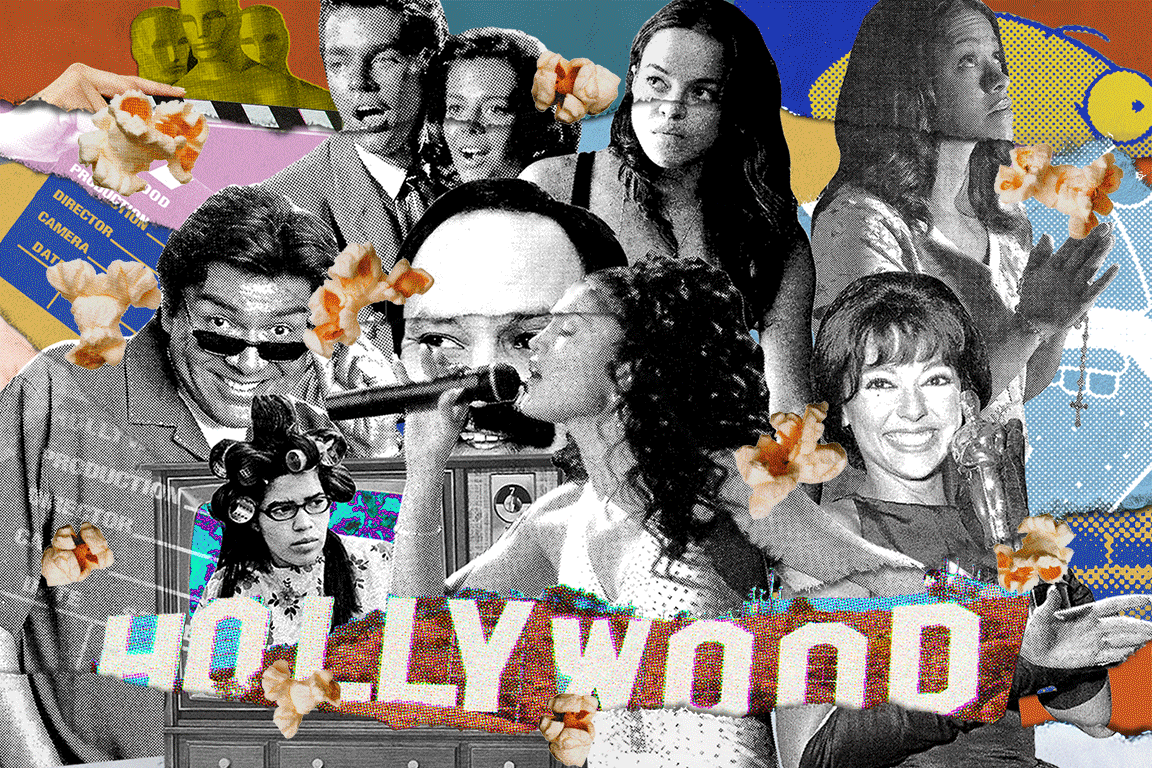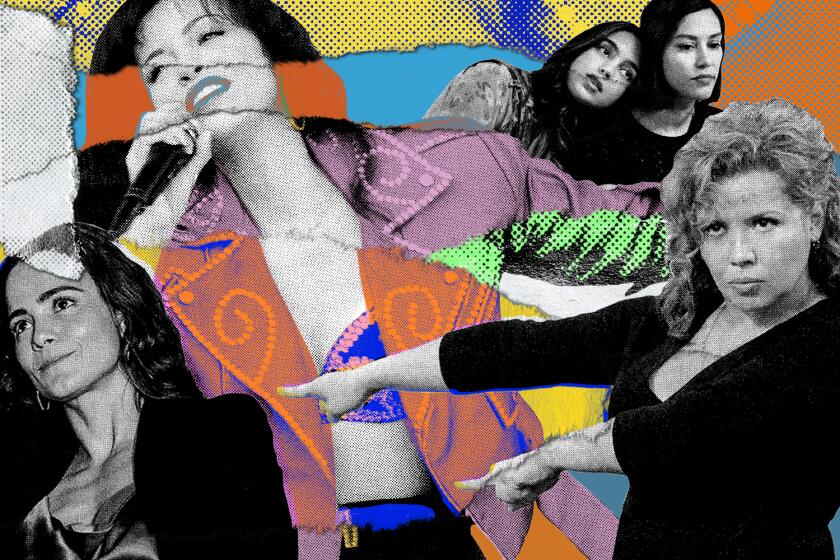SPECIAL REPORT
Hollywood's Latino Culture Gap
Times journalists examine the complicated history of Latinos in Hollywood and the actions being taken to increase their representation, which remains stubbornly low. FULL COVERAGE
If movie theaters are to bounce back after the pandemic, Hollywood will have to rely on a loyal audience it has long neglected: Latinxs.
The COVID-19 shutdown was brutal for the film industry. According to a report by the Motion Picture Assn., box office sales in the United States and Canada dropped by 80% in 2020. Studios postponed movie premieres by more than a year or released them on streaming platforms.
But now there’s a vaccine, and with mass inoculation comes the hope that audiences will return to their local cineplexes. Luckily for the industry, Latinxs can save the day.
You see, we love going to the movies. In 2019, we bought a quarter of all tickets despite accounting for only 18% of the U.S. population. Latinxs went to the cinema an average of 4.7 times that year, the highest per capita attendance of any ethnic or racial group. In comparison, white moviegoers averaged 3.2 visits.
2021’s numbers might not look all that different.
The summer movie season has just begun, and Latinxs are already showing up. Warner Bros.’ “The Conjuring: The Devil Made Me Do It” took the No. 1 spot at the box office last weekend, earning an estimated $24 million despite also premiering on HBO Max. According to Deadline, the paranormal flick performed best in Los Angeles, New York, Dallas, Houston and Chicago — all markets with significant Latinx populations. The film’s top grossing theater? The Cinemark Tinseltown in El Paso.
I’d be remiss if I didn’t mention that the most successful opening weekend in the Conjuring Cinematic Universe — there are eight films in total — came in 2018 with the release of “The Nun.” It earned $53.5 million domestically, and Latinxs made up 36% of its audience. Perhaps not surprisingly, it’s the only film in the franchise to prominently feature a Latinx character (Mexican actor Demián Bichir as a priest).
And then there’s “In the Heights.”
The cinematic adaptation of the Lin-Manuel Miranda musical set in the predominantly Latinx New York City neighborhood of Washington Heights is the biggest film to center our community since Pixar’s 2017 animated feature “Coco,” a two-time Oscar winner. Given that “In the Heights” features just about every actor with a Spanish surname not named Edward James Olmos, there is a high expectation that Friday’s release will end up being a watershed moment for Latinx representation on the big screen.
“We haven’t had a movie that feels like ‘Black Panther’ or ‘Crazy Rich Asians,’” lead actor Anthony Ramos recently told the Hollywood Reporter, referencing two movies that proved you could make a lot of money by telling Black and AAPI stories, respectively.
Ramos also noted that cast members would begin filming each day with rallying cries like “For la raza!” or “For the culture!,” a tacit acknowledgment that there’s a lot at stake in how “In the Heights” performs at the box office.
It’s hard to blame him for thinking that way. I’m not sure who decided that “In the Heights” needed to be the Latinx “Black Panther” or “Crazy Rich Asians,” but the discourse around the musical certainly feels like it’s our only shot at getting more of our stories on-screen.
It’s no surprise then that the National Assn. of Latino Independent Producers has teamed with Gold House, the Asian and Pacific Islander organization that organized a successful theater buyout campaign ahead of the 2018 premiere of “Crazy Rich Asians,” to launch a similar effort in support of “In the Heights” called #LatinxGoldOpen.
“Partnerships like this one are a substantive way to send the message that we see and support one another’s communities,” actor Daniel Dae Kim told the Hollywood Reporter.
“From our halmeonis to our abuelas, and our many languages from many countries, we hope to create a fuller, more complete narrative of what it means to be American.”
It’s definitely a noble effort, and I hope it succeeds. But even if “In the Heights” falls a dollar short of the studio’s projections, the truth is that Latinxs don’t need to prove to Hollywood that we can carry a big budget movie to the top of the box office. We’ve been doing it for two decades.
When “The Fast and the Furious” was released in 2001, nobody expected a $38-million action flick set in Los Angeles’ street racing scene to turn into a franchise that’s earned $6.15 billion to date over the course of 10 movies.
From the start, Latinxs have been one of the key drivers of this wild ride. When “Furious 7” premiered in 2015, we made up 37% of the opening weekend audience. When “The Fate of the Furious” premiered two years later, Latinxs bought 26% of all tickets on opening weekend.
In hindsight, it makes perfect sense that Latinxs would be drawn to these movies. With the exception of 2006’s “The Fast and the Furious: Tokyo Drift” (the third one) and the 2019 spinoff “Fast & Furious Presents: Hobbs & Shaw,” every movie has featured prominent cultural signifiers of Latinidad. With the setting (Los Angeles, Miami, the U.S./Mexico border, the Dominican Republic, Cuba), the cast (Michelle Rodriguez, Eva Mendes, Tego Calderón, Don Omar), the theme of family and even its frequent reggaeton beats, the franchise has woven Latinx culture into the films. Without revealing any spoilers, I can confirm that “F9” does the same thing.
This strategy has been by design. In 2009, after the release of “Fast & Furious” (the fourth one), a Universal executive told my colleague Reed Johnson that the studio intended to take care of the demographic group that had always “taken care of the franchise.”
It was this installment of the franchise that film historian Mary Beltrán called “a case study of Latinization of a mainstream film.”
“It is not surprising that a film franchise that has built one of its greatest appeals on its embodiment of cultural mingling and border crossing has expanded that vision to embrace the Latino diaspora within and outside the United States,” she wrote in 2013.
Universal Studios knows who has been fueling the engine of this franchise. It’s the reason why “F9’s” Vin Diesel and John Cena recently did an in-game promotion for the movie during the second leg of the Liga MX final. The Mexican professional soccer league is the most watched in the United States. That match, which was broadcast in Spanish by Univision, was seen by 3 million Latinxs.
“F9” is going to be a massive hit when it premieres in the United States on June 25. It’s already made $255 million in Asia and parts of the Middle East since opening there in mid-May. When it does, you better believe there’s going to be a story or two about how Latinxs supported the movie. We will have done our part.
Now it’s time for Hollywood to do theirs.












